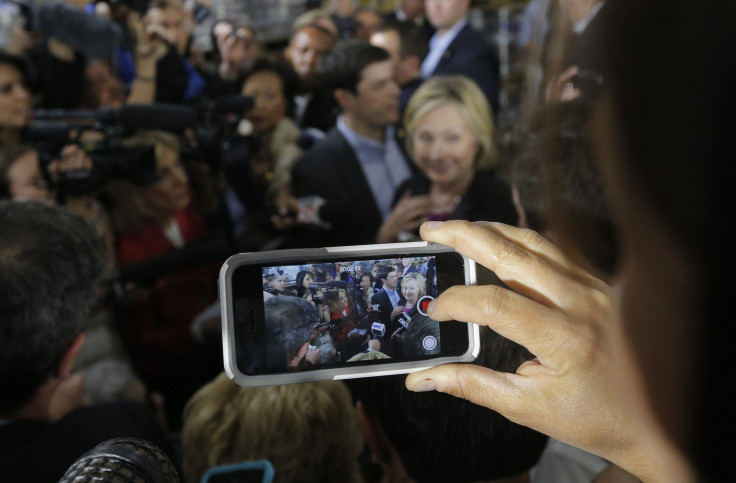2016 Presidential Race Unfolds On Twitter, Facebook As New Social Media Trends Shape White House Campaigns

Social media may prove to be more crucial to the 2016 presidential race than past election cycles as voters increasingly rely on various networking platforms to keep informed. A new study released Tuesday reveals that the majority of Facebook and Twitter users consume their news on those sites.
The report, which was conducted by the Pew Research Center in association with the John S. and James L. Knight Foundation, found that 63 percent of users on each of the social media platforms visit the site for news updates. These numbers are on the rise from 2013, when 52 percent of Twitter users and 47 percent of Facebook users reported finding their news on the sites. The increase was seen across all age groups.
“There are many elements that can be at play with users of Facebook and Twitter when they are on these platforms,” said Amy Mitchell, director of journalism research at the Pew Research Center. “It may be that they are on the platform and news ends up being something they do or the degree to which both Facebook and Twitter have put increased emphasis on news engagement and accessibility.”
Politics was the most prevalent of all the news subjects that users reported they came across on social media and a growing roster of 2016 candidates are paying attention to the shift in how people consume news. Many have wasted no time this election season establishing a social media presence.
Instead of appearing on a podium to announce their candidacy, some presidential hopefuls have turned to digital platforms. Wisconsin Gov. Scott Walker took to Twitter on Monday to declare “I’m in,” and U.S. Sen. Ted Cruz, R-Texas, tweeted a video kickoff to launch his run for the presidency in March. In April, Democratic candidate Hillary Clinton released a two-minute YouTube video “Getting Started” to share the news of her presidential run.
Read Hillary's ideas for the economy in her own words: http://t.co/2ta3l1zMU8 pic.twitter.com/Ey3jGrNagx
— Hillary Clinton (@HillaryClinton) July 14, 2015And while former Florida Gov. Jeb Bush announced his bid for presidency in front of a live crowd, his aides posted short video clips directly to Snapchat throughout the event.
“In 2007, John Edwards was the first to announce his candidacy on YouTube,” said Lindsay Hoffman, associate professor of communication and the associate director of the Center for Political Communication at the University of Delaware. “At that time YouTube was a novelty, so it’s about novelty and it’s about engaging with citizens in a more personal way that does not separate themselves from them and says ‘I’m like one of you.’ That’s the thing behind these social media campaigns.”
For Republicans, this campaign season is a chance to play catch-up with technology and get ahead of Democrats. The candidates are adopting President Barack Obama’s social media strategy from his 2008 and 2012 campaigns, which were lauded for galvanizing younger and minority voters.
“There was an aversion to engaging with the public online before 2008 when the Obama campaign was like ‘We are going to risk it. We are going to try it and we are going to let them communicate not only with us, but with them,’ ” Hoffman said. “He was really successful using social media to microtarget voters and that is going to be a big story this election.”
Get behind Scott. ReTweet, show your support and create an account. #Walker16 http://t.co/VRRU6uKamL pic.twitter.com/eWsO28hGS0
— Scott Walker (@ScottWalker) July 13, 2015Some candidates see social media as a means to connect with voters in a more transparent and personal way.
“Candidates are discovering this is the new town hall, this is where everyone is, and are like, ‘I should go down there and try to talk to people,’ ” Hoffman said.
A glance at business titan and presidential hopeful Donald Trump’s Twitter feed reveals constant and unvarnished exchanges between him and potential voters. It is not unusual for Trump, whose account bears more than 26,000 tweets, to retweet a dozen pledges of support from his followers in succession.
And if number of Twitter followers is any indication, Trump is among the front-runners for the social media election. He has more than 3.2 million followers, just slightly behind Clinton, who has amassed around 3.8 million followers. By comparison, Bush and Walker have around 226,000 and 152,000 Twitter followers, respectively.
"@kavemanrj @realDonaldTrump Amazing work trump! I believe you will do the same for our country."
— Donald J. Trump (@realDonaldTrump) July 14, 2015Facebook does not have the same reach. Trump’s Facebook page counts around 2 million likes, while Clinton has about 1 million. But some of the other candidates' pages receive a lot less attention. New Jersey Gov. Chris Christie, another 2016 GOP contender, has around 190,000 likes.
All of the candidates also have Instagram accounts, which was not part of Republican candidate Mitt Romney's social media portfolio in the 2012 presidential election. Walker used the photo-sharing network in the days leading up to his presidential run announcement to tease photos of parts of his campaign logo, while Clinton's account has allowed her to show her sense of humor. She posted a photo with a caption Saturday that said, "With great pantsuits comes great responsibility," poking fun at her preferred ensemble.
Social media platforms that enable live engagement, such as live-video app Periscope, also have a lot of potential to reach new voters this election, Hoffman said.
"2016 will be about the live components -- live-tweeting, live-streaming -- being engaged in the moment in a seemingly personal way," Hoffman said.
And as more social media avenues emerge, candidates will be trying to get their message across through them.
This election, Hoffman said, "is about chasing the next big thing."
© Copyright IBTimes 2024. All rights reserved.






















